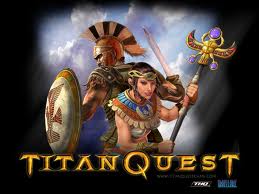In the first case it would be interesting if the NPC who had the artifact in the first place respawned with out it - you'd miss out on the best loot but they'd also be easier to take down. In some cases, like with Umbra, the NPC should probably only appear if they can carry the artifact - although in that situation the remainder of their loot should be mundane or they should be replaced by someone else in the mean time.
90 posts
• Page 2 of 4 • 1, 2, 3, 4
Artifact Discussion [merged similar threads]
In the first case it would be interesting if the NPC who had the artifact in the first place respawned with out it - you'd miss out on the best loot but they'd also be easier to take down. In some cases, like with Umbra, the NPC should probably only appear if they can carry the artifact - although in that situation the remainder of their loot should be mundane or they should be replaced by someone else in the mean time.
-

Juanita Hernandez - Posts: 3269
- Joined: Sat Jan 06, 2007 10:36 am
Not an MMO player here. Micro-transactions exactly what they sound like? Basically buying pixels to give yourself an edge or taking a shortcut when you don't want to grind?
That is one definition of it, though not all MT models go that route.
The best MT models are those that focus on the sale of convenience items (XP boosts, additional inventory slots, additional character slots, that sort of thing), Cosmetic items (outfits that do not have stats but allow you additional customization options when the gear you wear makes you look like a clown), and content access (essentially additional chapters of gameplay content over and above what the game launched with, able to release more regularly and allows the developer to avoid expenses associated with retail releases.)
One of the biggest points of confusion with subscription-based MMOs is the idea that the subscription pays for content development. It doesn't. I would suggest actually reading the terms of service you'll be asked to agree to when the game comes out. Somewhere in there will be what I call the NONE clause. It will say something to the effect that the subscruiption fee grants you access to the service only, and that the developer is not obligated to deliver and you are not entitled to receive anythuing beyond access. So in a sense, the NONE clause grants the developer the license to sit on their butt and just rake in the revenue.
Another misconception is that the developers get the subscription revenue directly. They don't. The parent company gets it all and pays out the sallaries agreed upon through contracts with their employees in the different departments involved. Some parent companies refuse to invest in their development teams resulting in MMOs that do not grow. You can recognize these by the MMOs that have a large paying player base but the game goes months and months without additional content and the typical explanation from the devs of "We just don't have the manpower to do that right now." It's not an excuse. Odds are they are being completely honest.
If the game is microtransaction-driven, the revenue flow still goes the same way, to the parent company first. But in the case of microtransactions, money is only made on things that are actually produced and delivered. If the developer of a MT-driven game says that they won't charge for playable content, then beware of heavy sale of fluff items on the MT-store and other revenue generation ploys like lockboxes that contain a random item, one of which is highly sought after and very rare, and needs a key purchased in the MT store to open. This is not necessarily a bad mechanic, where if done rightm you find the boxes in fixed locations, and if you want to open it, you just buy the key. But some developers employ an in-your-face approach which cause the boxes to drop when you kill something, and you get deluged by them, and the drop-rate of the ultra-rare item is so low that you can buy hundreds of keys and never get it, leading to the feeling of being cheated. If the MMO in question goes this route, you can hang up seeing regular playable content releases as the MT-for-fluff model only reinforces the NONE clause.
Striking the right balance between MT-products and MT-pricing, an MMO can sustain itself and turn a heafty profit at the same time. In my opinion the right MT-products include the sale access tokens that let you in to the latest playable content, and the production of said content given a much higher priority than fluff items that would also be available. I would rather pay for more stuff to do than more stuff to wear. I would even accept such MT-products in a subscription-based game if the content packs replace retail expansions and are priced so that the content releases over a given period do not cost any more than what a retail expansion would cost at the same time interval. Like I said, subscription fees do not pay for content development.
MTs can be a blessing or a curse, depending on how they are handled.
-

ZANEY82 - Posts: 3314
- Joined: Mon Dec 18, 2006 3:10 am
The one-per server unique item will not work in todays games. Here is what happens...Say the UBER SWORD OF UNIQUENESS DROPS. Reymas gets it. He feels awesome and goes out and fights with it. Vadagar kills him and takes it. Reymas gets his revenge and takes it back but then decides the game makes him puke in his mouth too much and he quits. Now that one unique weapon is sitting on his character forever and nobody else can get it.
Put a limit on it like you have to log in X amount of times to keep it? People will work with their real life friends to exchange kills so their level 1 alt can hold these unique weapons just to grief other players.
I think a better route is introducing these weapons like once a year, and then making it such a chore to get them that it turns most other players off. When I quit FFXI I was just one of two US players in the world who had Exalibur. There weren't many Japanese who had it either. It took me and my guild well over a full year and a half to farm everything for it and do all the necessary steps. If you do it that way it will keep the items limited.
I do not know if FFXI was running rampant with those swords towards the end of its time but like I said, I played six years and when I quit it was still a really rare weapon.
Put a limit on it like you have to log in X amount of times to keep it? People will work with their real life friends to exchange kills so their level 1 alt can hold these unique weapons just to grief other players.
I think a better route is introducing these weapons like once a year, and then making it such a chore to get them that it turns most other players off. When I quit FFXI I was just one of two US players in the world who had Exalibur. There weren't many Japanese who had it either. It took me and my guild well over a full year and a half to farm everything for it and do all the necessary steps. If you do it that way it will keep the items limited.
I do not know if FFXI was running rampant with those swords towards the end of its time but like I said, I played six years and when I quit it was still a really rare weapon.
-

Unstoppable Judge - Posts: 3337
- Joined: Sat Jul 29, 2006 11:22 pm
Artifacts are tricky, but I like the idea of them being temporary rewards (as the lore has established they may disappear after a time) or unique items that can be looted in pvp.
In the first case it would be interesting if the NPC who had the artifact in the first place respawned with out it - you'd miss out on the best loot but they'd also be easier to take down. In some cases, like with Umbra, the NPC should probably only appear if they can carry the artifact.
In the first case it would be interesting if the NPC who had the artifact in the first place respawned with out it - you'd miss out on the best loot but they'd also be easier to take down. In some cases, like with Umbra, the NPC should probably only appear if they can carry the artifact.
Yeah that would be the point, the NPCs that initially spawn with the artifacts would only really exist for the reason of getting the Artifacts out into the world where they can be fought over by the playerbase, after that they serve no real purpose and should only respawn when an artifact vanishes from the world for some reason and needs to be redistributed among the players again. Umbra presents a unique opportunity as we know through the lore that Umbra usually changes hands when its previous owner is defeated and that those who come into possession of Umbra usually take on the Identity of Umbra as well, what I would love to see is players who come into possession of Umbra also have their identities changed to Umbra for as long as they hold the artifact.
-

Jonathan Windmon - Posts: 3410
- Joined: Wed Oct 10, 2007 12:23 pm
Artifacts are tricky, but I like the idea of them being temporary rewards (as the lore has established they may disappear after a time) or unique items that can be looted in pvp. In the first case it would be interesting if the NPC who had the artifact in the first place respawned with out it - you'd miss out on the best loot but they'd also be easier to take down. In some cases, like with Umbra, the NPC should probably only appear if they can carry the artifact - although in that situation the remainder of their loot should be mundane or they should be replaced by someone else in the mean time.
Thanks, HD, for bringing this back on topic. I didn't mean to side-track it.
I had thought about suggesting that the artifact be lootable, but then you open up a major can of worms. The only players who like the idea of being able to loot other players are those who would use the ability to grief people to no end. This was proved years agon in Ultima Online, when tere was only one facet of the game, and you were open to PvP gank squads at any time. You could be traveling along the road, minding your own business. and out of nowhere an entire group of players would jump out, kill you, and loot you clean. This is where the hatred of forced player grouping began, because if you wanted to get anywhere with any guarantee of safety, you had to travel in groups to discourage the gankers from putting forth the trouble. When Ultima Online adopted the two-facet system, where an instance of the entire world allowed open PvP and the other didn't, the ones who hated it the most where the Player-killers because it robbed them of the cheap thrill they could get by wasting someone else's time.
Being ganked and strip-looted (literally, if you were just wearing clothes that offered no protection, they would take those too), was a pain with just common items. If you were carrying something rare or important, it was enough to make you want to quit. If the ability to loot rare artifacts off players in PvP goes in, and those artifacts are only yours temporarily, then the outcry will be ten times worse. So not a good idea.
Better to go with the yours for 30 days approach and then someone else can have a chance at finding it. And in retrospect, the MT I proposed for extending the time would not be a good idea. Even 50/50 odds of being able to hold onto it do not guarantee that the ritual nwon't fail several times in a row. And I would be very angry if I ended up spending several dollars on the ritual scrolls if they fail.
-

bonita mathews - Posts: 3405
- Joined: Sun Aug 06, 2006 5:04 am
The one-per server unique item will not work in todays games. Here is what happens...Say the UBER SWORD OF UNIQUENESS DROPS. Reymas gets it. He feels awesome and goes out and fights with it. Vadagar kills him and takes it. Reymas gets his revenge and takes it back but then decides the game makes him puke in his mouth too much and he quits. Now that one unique weapon is sitting on his character forever and nobody else can get it.
That's why I suggested having unique artifacts only ownable for 30 days and then they vanish, the way they did in Arena and Daggerfall. If you found one, you made the most of it while you had it.
-

Taylor Bakos - Posts: 3408
- Joined: Mon Jan 15, 2007 12:05 am
That's why I suggested having unique artifacts only ownable for 30 days and then they vanish, the way they did in Arena and Daggerfall. If you found one, you made the most of it while you had it.
-

lydia nekongo - Posts: 3403
- Joined: Wed Jul 19, 2006 1:04 pm
Being ganked and strip-looted (literally, if you were just wearing clothes that offered no protection, they would take those too), was a pain with just common items. If you were carrying something rare or important, it was enough to make you want to quit. If the ability to loot rare artifacts off players in PvP goes in, and those artifacts are only yours temporarily, then the outcry will be ten times worse. So not a good idea.
Only the artifact itself would be lootable meaning that the only thing that the player would lose upon death is the artifact, the rest of his gear would remain intact. The artifacts should be powerful but I wouldnt want to see these artifacts require the player to put a big investment down in order to aquire these items since odds are they could lose the item the next day.
The one-per server unique item will not work in todays games. Here is what happens...Say the UBER SWORD OF UNIQUENESS DROPS. Reymas gets it. He feels awesome and goes out and fights with it. Vadagar kills him and takes it. Reymas gets his revenge and takes it back but then decides the game makes him puke in his mouth too much and he quits. Now that one unique weapon is sitting on his character forever and nobody else can get it.
Put a limit on it like you have to log in X amount of times to keep it? People will work with their real life friends to exchange kills so their level 1 alt can hold these unique weapons just to grief other players.
Put a limit on it like you have to log in X amount of times to keep it? People will work with their real life friends to exchange kills so their level 1 alt can hold these unique weapons just to grief other players.
If you would read the earlier posts in this thread you will see that it has already been aknowleged that there would have to be some sort of system to keep the items in play and keep the player from exploiting the system and holding onto the item indefinately, I know the system I propose is not without problems but there are also many ways around these problems as well.
The whole point of this idea is to add a new layer to PvP by making those who possess the artifacts much more formidable in combat but also making them a huge target for those who also wish to get their hands on these artifacts.
-

BEl J - Posts: 3397
- Joined: Tue Feb 13, 2007 8:12 am
I am sorry if you feel I didn't read the whole thread. I have. I was just chiming in. I support this idea of your thread.
-

Josee Leach - Posts: 3371
- Joined: Tue Dec 26, 2006 10:50 pm
I am sorry if you feel I didn't read the whole thread. I have. I was just chiming in. I support this idea of your thread.
Ah ok then I apologise, you are right though and the idea does have problems that need to be ironed out however I do feel that there are a lot of ways around them,
-

Sophh - Posts: 3381
- Joined: Tue Aug 08, 2006 11:58 pm
That's why I suggested having unique artifacts only ownable for 30 days and then they vanish, the way they did in Arena and Daggerfall. If you found one, you made the most of it while you had it.
Of course, you could make the artifact untradeable. But then most artifacts will sit on characters without being used. Why would my warrior want Savior's Hide, or Azura's Star? This simply hoggs the artifact for a full month without any effect on the game.
Maybe you should be able to dismiss an artifact if you don't want it, so it gets "recycled" and another player has the chance to get it.
-

Prue - Posts: 3425
- Joined: Sun Feb 11, 2007 4:27 am
However, you could abuse that system just by trading the artifact with another player, back and forth, and keep the artifact between the two of your forever.
Of course, you could make the artifact untradeable. But then most artifacts will sit on characters without being used. Why would my warrior want Savior's Hide, or Azura's Star? This simply hoggs the artifact for a full month without any effect on the game.
Maybe you should be able to dismiss an artifact if you don't want it, so it gets "recycled" and another player has the chance to get it.
Of course, you could make the artifact untradeable. But then most artifacts will sit on characters without being used. Why would my warrior want Savior's Hide, or Azura's Star? This simply hoggs the artifact for a full month without any effect on the game.
Maybe you should be able to dismiss an artifact if you don't want it, so it gets "recycled" and another player has the chance to get it.
-

vanuza - Posts: 3522
- Joined: Fri Sep 22, 2006 11:14 pm
Make them bound. You can't trade them.
I hate bound items. But then these artifacts are generally supernatural in nature, so maybe if you agree to take one up, you're stuck with it until it is through with you... Unless you take it to the apropriate shrine and lay it on the altar... Then you are free of it and it gets re-seeded somewhere in the world.
-

Darlene Delk - Posts: 3413
- Joined: Mon Aug 27, 2007 3:48 am
I hate bound items. But then these artifacts are generally supernatural in nature, so maybe if you agree to take one up, you're stuck with it until it is through with you... Unless you take it to the apropriate shrine and lay it on the altar... Then you are free of it and it gets re-seeded somewhere in the world.
Unfortunately Bound items exist in MMOs for a reason and if there were an artifact system like the one I propose then artifacts would have to be BoP in order to stop such items being traded around with other players in your faction in some lame attempt to keep artifacts out of play and in the possession of your faction indefinately.
-

roxanna matoorah - Posts: 3368
- Joined: Fri Oct 13, 2006 6:01 am
Unfortunately Bound items exist in MMOs for a reason and if there were an artifact system like the one I propose then artifacts would have to be BoP in order to stop such items being traded around with other players in your faction in some lame attempt to keep artifacts out of play and in the possession of your faction indefinately.
Bound items exist in MMOs for one reason: to FORCE the player to HAVE to go through a pain in the but grind to get the item in question. Ultima Online didn't need bound items and it did okay. Why? Because the freedom to give an item to another player or sell it on one's vendor actuallty encouraged what sadly has become watered down in MMOs today: Social Interaction.
Bound items are an unrealistic control mechanism just to give developers an excuse not to develop new content on a more regular basis... Say you have a raid with several pieces of gear as part of a complete set. The gear is BOA, meaning you cannot trade it. Okay... most raids are on a random loot drop mechanic, with some pieces more difficult to obtain than the others. You see where I am going? If someone wants the complete set, they have to run the raid over and over until chance lets them get everything. And because it cannot be traded, there is no "I got the Boots of Blablabla again. Here. I know you need them" option. In ultima Online, you could have someone run down th the depths of some dungeon and come out with a whole bunch of some enchanted whatever. He'd keep a few for himself in case he got ganked and robbed, but he'd put the rest up for sale so those who, get this, did not WANT to go to the depths of a dungeon to get the item would not have to.
It all comes back to what MMOs have gotten away from: FREEDOM.
I played UO for several years. In all that time, I think I explored only part of the shallowest level of a few dungeons. Not because I bought dungeon gear from someone. I didn't. But because there were other areas of interest that occupied my time that were more about supporting my guild as a Fletcher. We had a lot of archers and there were days where all I did was craft arrows and put them in a chest we had designated for dropping off and picking up essentials. Many of these archers were into dungeon crawls. So while I myself didn't go, I was able to contribute.
That is what is lost on MMO developers these days. Some people just want to be useful without having to go raid or do PvP. And in some cases, without having to go run solo quests. They want to define their own personal goals and just do them. I never once had any fellow guild members in UO tell me I needed to PvP or go dungeon crawling with them. I was treated with kindness and respect by everyone, because what I chose to do helped them. I never asked for gold. I did what I did because I wanted to. Because I knew it served a purpose... and most importantly, because the game actually ALLOWED me to.
So I say no to bound items, unless there is a really good reason, like I suggested for artifacts supernaturally bound until the item is done with the player unless the player does some required action to make the item release its hold on the player.
I want MMOs to get back to being socially friendly. Where developers don't force players down any particular road. The thing is, if there was ever an IP that would be supportive of this, it would have to be The Elder Scrolls.
-

Steeeph - Posts: 3443
- Joined: Wed Apr 04, 2007 8:28 am
That's why I suggested having unique artifacts only ownable for 30 days and then they vanish, the way they did in Arena and Daggerfall. If you found one, you made the most of it while you had it.
even better

-

Mike Plumley - Posts: 3392
- Joined: Wed Sep 05, 2007 10:45 pm
I hate bound items. But then these artifacts are generally supernatural in nature, so maybe if you agree to take one up, you're stuck with it until it is through with you... Unless you take it to the apropriate shrine and lay it on the altar... Then you are free of it and it gets re-seeded somewhere in the world.
oh yah
I like this too

-

Arrogant SId - Posts: 3366
- Joined: Sat May 19, 2007 11:39 am
id rather have every artifact be there once. its realy hard to get and it doesnt stay with you long. that makes realy no sense from a gameplay standpoint but it would be realy cool.
-

Rude Gurl - Posts: 3425
- Joined: Wed Aug 08, 2007 9:17 am
It should go back into the game somewhere after it leaves you though. I seem to remember in Arena finding the same artifact more than once. The odds of it happening just need to be rare.
-

leni - Posts: 3461
- Joined: Tue Jul 17, 2007 3:58 pm
It should go back into the game somewhere after it leaves you though. I seem to remember in Arena finding the same artifact more than once. The odds of it happening just need to be rare.
I dont want these items to be incredibly elusive and hidden at the back of some random dungeon so that the odds of someone finding them are so rare that they might as well not exist, the whole point of these items would be for them to be out in the world and fought over by the playerbase, if the item for some reason needs to be re-seeded into the world then it should be as simple as spawning a unique mob in some random location and have him wander the globe until someone finds him and takes the artifact back to be fought over once again. For instance if Umbra needed to be re-seeded then a unique NPC named Umbra would start roaming the land until someone finds him and takes the blade back off him, think of it kind of like capture the flag.
-

Blaine - Posts: 3456
- Joined: Wed May 16, 2007 4:24 pm
Really? I thought the idea was to have some really cool ancient rare magical artifacts that you can find through, I don't know... EXPLORING the world, including the depths of dungeons and ancient crypts... Of course, it doesn't have to be dungeons or crypts. It could be some hard to find or not obvioulsy accessible area in the open world.
Here's the deal, though.
It should not be what you or I want. It should be what is best for the game as a whole. See, I want no part of PvP. I also want no part of Raids. I just want to enjoy the world, explore it and discover things, which is one of the major draws of The Elders Scrolls, for me. That's the playstyle I choose. And it is just as valid as the one a PvPer or Raider chooses. All playstyles should have the potential of finding artifacts. Raid dungeons, PvP battlegrounds, Normal exploration areas. All could have containers or spawn points for artifacts. That makes if fair.
Here's the deal, though.
It should not be what you or I want. It should be what is best for the game as a whole. See, I want no part of PvP. I also want no part of Raids. I just want to enjoy the world, explore it and discover things, which is one of the major draws of The Elders Scrolls, for me. That's the playstyle I choose. And it is just as valid as the one a PvPer or Raider chooses. All playstyles should have the potential of finding artifacts. Raid dungeons, PvP battlegrounds, Normal exploration areas. All could have containers or spawn points for artifacts. That makes if fair.
-

Lily - Posts: 3357
- Joined: Mon Aug 28, 2006 10:32 am
I dont want these items to be incredibly elusive and hidden at the back of some random dungeon so that the odds of someone finding them are so rare that they might as well not exist, the whole point of these items would be for them to be out in the world and fought over by the playerbase, if the item for some reason needs to be re-seeded into the world then it should be as simple as spawning a unique mob in some random location and have him wander the globe until someone finds him and takes the artifact back to be fought over once again. For instance if Umbra needed to be re-seeded then a unique NPC named Umbra would start roaming the land until someone finds him and takes the blade back off him, think of it kind of like capture the flag.
However, I would vote for a shorter duration until the artifact vanishes again. A week at most. You want to keep it fluctuating so players have a better chance to see it in their "lifetime":
-

Veronica Martinez - Posts: 3498
- Joined: Tue Jun 20, 2006 9:43 am
Really? I thought the idea was to have some really cool ancient rare magical artifacts that you can find through, I don't know... EXPLORING the world, including the depths of dungeons and ancient crypts... Of course, it doesn't have to be dungeons or crypts. It could be some hard to find or not obvioulsy accessible area in the open world.
Here's the deal, though.
It should not be what you or I want. It should be what is best for the game as a whole. See, I want no part of PvP. I also want no part of Raids. I just want to enjoy the world, explore it and discover things, which is one of the major draws of The Elders Scrolls, for me. That's the playstyle I choose. And it is just as valid as the one a PvPer or Raider chooses. All playstyles should have the potential of finding artifacts. Raid dungeons, PvP battlegrounds, Normal exploration areas. All could have containers or spawn points for artifacts. That makes if fair.
Here's the deal, though.
It should not be what you or I want. It should be what is best for the game as a whole. See, I want no part of PvP. I also want no part of Raids. I just want to enjoy the world, explore it and discover things, which is one of the major draws of The Elders Scrolls, for me. That's the playstyle I choose. And it is just as valid as the one a PvPer or Raider chooses. All playstyles should have the potential of finding artifacts. Raid dungeons, PvP battlegrounds, Normal exploration areas. All could have containers or spawn points for artifacts. That makes if fair.
-

Francesca - Posts: 3485
- Joined: Thu Jun 22, 2006 5:26 pm
Interesting... That could work.
One important thing for all the artifacts, regardless of how they are introduced, is that they should be unique per server, and therefore only wieldable by one player at a time and for only a limited time to prevent one person from hording them. This way, if you find one, you know you've got something special.
And I agree with Faulgor. A week is long enough.
One important thing for all the artifacts, regardless of how they are introduced, is that they should be unique per server, and therefore only wieldable by one player at a time and for only a limited time to prevent one person from hording them. This way, if you find one, you know you've got something special.
And I agree with Faulgor. A week is long enough.
-

Star Dunkels Macmillan - Posts: 3421
- Joined: Thu Aug 31, 2006 4:00 pm
It should not be what you or I want. It should be what is best for the game as a whole.
That is the whole bloody point! I am trying to suggest an idea that would work well with how the game already seems to be structured, we already know that there is going to be a big focus on endgame PvP with capturable forts, towns and even the Imperial city so why not extend that to have players fighting over artifacts of great power as well? We already know that a player from the faction that currently holds the Imperial city can be crowned Emperor (and no a player cant be Emperor through any means other than PvP, so if you think that is "unfair" then fairness can go svck a lemon) so why not have a player take on the identity of Umbra? Not only does such a gameplay mechanic fit within the current context of how the game already works it also makes for a great gameplay mechanic that is also based around the lore of the universe.
What you want and what you propose would not be best for the game as a whole, what you want is not based around how the game works but more your own misguided ideals of how the game should work. Unfortunately for you you cant just wander the world and have high end gear fall into your lap, high end equipment needs to be earned. In most MMOs today there is only really 3 ways to get high end gear, crafting, endgame raids and pvp rewards. We can already take crafting out of the picture as these artifacts wont be craftable which leaves us with endgame raids and pvp rewards. If these items were the reward of high end raids then it is likely that these items would take a great deal of effort to get which if you only got to keep these items for 30 days and only 1 person can have them at any 1 time on a server as you suggest then all that effort would be for naught. If artifacts were the reward of high end raids then they would most likely work how they usually work in most MMOs which is what Varking posted here
I think a better route is introducing these weapons like once a year, and then making it such a chore to get them that it turns most other players off. When I quit FFXI I was just one of two US players in the world who had Exalibur. There weren't many Japanese who had it either. It took me and my guild well over a full year and a half to farm everything for it and do all the necessary steps. If you do it that way it will keep the items limited.
I do not know if FFXI was running rampant with those swords towards the end of its time but like I said, I played six years and when I quit it was still a really rare weapon.
I do not know if FFXI was running rampant with those swords towards the end of its time but like I said, I played six years and when I quit it was still a really rare weapon.
Which means that while they would be hard to get they would be permanent rewards and more than one person on a server would be able to own them provided they put in the effort meaning that they are no longer unique. This leaves the only viable option for implementing unique artifacts that every player has a chance of holding (even if it is just for a brief period of time) is to have them won and lost through the constant battles of endgame PvP.
-

Angus Poole - Posts: 3594
- Joined: Fri Aug 03, 2007 9:04 pm
90 posts
• Page 2 of 4 • 1, 2, 3, 4
